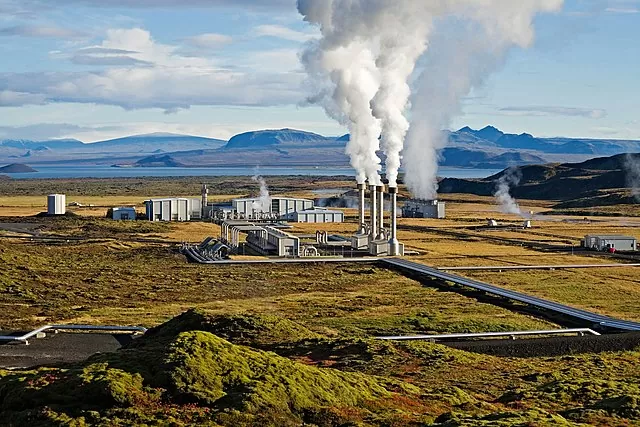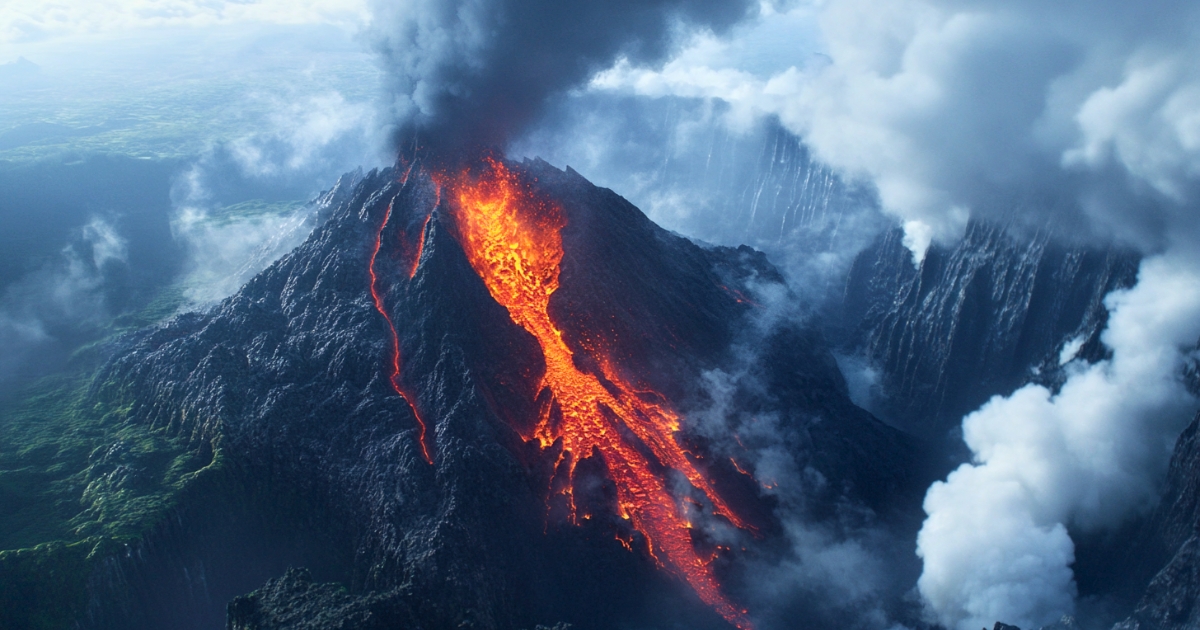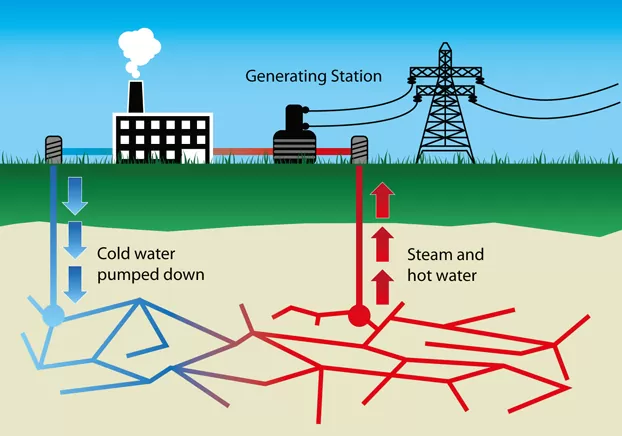The deafening roar of erupting lava, towering plumes of grey smoke, and ground-shaking tremors – volcanic eruptions are a testament to Earth’s overwhelming power. On the other hand, soaking in a steaming outdoor hot spring, finding solace for both body and mind, is another gift that volcanoes offer. This terrifying yet captivating force of nature actually holds the potential to become our future source of clean energy.
Geothermal energy is gaining attention as a renewable resource from volcanic regions. Although not as widely recognized as wind or solar energy, harnessing the Earth’s natural heat could become a new option for sustainable energy.

The Nesjavellir Geothermal Power Plant in Iceland. The mountains in the background are a testament to the region’s volcanic activity. By Gretar Ívarsson
The Science of Geothermal Energy
Geothermal energy utilizes heat generated by natural processes deep within the Earth. The Earth’s core is at an astonishing temperature of about 5,400°C, and this heat gradually moves towards the surface. Usually, this heat only warms rocks and groundwater near the surface, but in volcanically active regions, the intensity of heat increases dramatically.
Volcanoes act like giant vents, bringing magma (molten rock) closer to the Earth’s surface. While some of this magma may erupt, most of it remains underground, continuously heating the surrounding rocks and water.
When this heated water reaches the surface, it manifests as hot springs or geysers. These phenomena can last for thousands of years, demonstrating the long-term stability of geothermal energy.
How Geothermal Energy is Harnessed
To convert geothermal energy into electricity, engineers first need to identify geothermal hotspots. They search for areas where magma is close to the surface and drill deep wells. These wells are drilled until they reach heated rocks and water.
Steam brought to the surface through these wells is directed to power plants. There, it rotates turbines, driving generators to produce electricity. After power generation, the steam is cooled and reverts to water.
This water is then reused for further efficiency. For example, it might be used to vaporize another liquid with a lower boiling point (such as butane) to drive a secondary generator. Afterward, the water is returned underground to be reheated, and the cycle repeats.
This process is based on the fact that the Earth continuously generates heat. That’s why geothermal energy is truly a renewable resource.
Advantages of Geothermal Energy
Geothermal energy has many advantages compared to other energy sources. First, it’s renewable. The Earth’s internal heat is continuously generated, so there’s no worry about depletion.
Also, geothermal power plants emit far less pollutants, waste, and greenhouse gases compared to plants that burn coal, gas, oil, or use nuclear energy. This is crucial from the perspective of combating global warming.
Furthermore, geothermal energy sources can be utilized for decades or even longer. Unlike other renewable energy sources such as solar and wind, geothermal energy is available 24/7, 365 days a year. It’s not affected by weather or time of day, allowing for stable power supply.
Global Initiatives in Geothermal Energy
Geothermal energy is already being used in many places around the world, especially in regions with active volcanic activity.
- Iceland: Iceland is a pioneer in geothermal energy use. About 25% of its electricity is supplied by geothermal energy, with nearly 100% of its electricity coming from renewable sources. Leveraging its geographical characteristics of being situated on many active volcanoes, Iceland uses geothermal energy not only for power generation but also for district heating and greenhouse agriculture.
- New Zealand: New Zealand has one of the highest proportions of geothermal power generation in the world. About 17% of its electricity is supplied by geothermal energy, with a unique approach that combines traditional Maori geothermal use with the latest technology.
- Philippines: The Philippines is the world’s third-largest geothermal energy producer. About 14% of its domestic electricity is supplied by geothermal energy, with active development leveraging its geographical characteristics as a volcanic archipelago.
- Indonesia: Indonesia is said to have the world’s largest geothermal resource. Currently, only about 5% of its electricity is supplied by geothermal energy, but there are plans to triple geothermal power capacity by 2025.
- United States: The United States is the world’s largest geothermal energy producer. It’s actively used especially in western volcanic regions such as California and Nevada. Recently, efforts have been focused on developing Enhanced Geothermal System (EGS) technology.
- Japan: Japan is the world’s third-largest geothermal resource holder, but its utilization is limited. However, since the Great East Japan Earthquake in 2011, interest in renewable energy has increased, and geothermal development is gradually progressing.
Challenges and Specific Countermeasures
While geothermal energy has many advantages, there are also some challenges. Here are the main challenges and their countermeasures:
- High Initial Costs: Building geothermal power plants requires significant initial investment.
Countermeasures: Introduction of government subsidies and tax incentives, guaranteeing long-term power purchase contracts to promote private investment, cost reduction through technological innovation (e.g., development of more efficient drilling technologies) - Geographical Constraints: Geothermal resources are concentrated in specific regions.
Countermeasures: Development of Enhanced Geothermal System (EGS) technology, development of small-scale geothermal power systems - Environmental Impact: There are risks of land subsidence and minor earthquakes associated with geothermal development.
Countermeasures: Introduction of continuous ground monitoring systems, development of water injection optimization technologies - Emission of Harmful Gases: Geothermal fluids may contain harmful gases such as hydrogen sulfide.
Countermeasures: Adoption of closed-loop systems, improvement of gas removal systems - Resource Depletion: Excessive extraction may lead to depletion of geothermal resources.
Countermeasures: Introduction of sustainable resource management plans, improvement of geothermal reservoir simulation technologies
Latest Technological Innovations
The field of geothermal energy has seen remarkable technological innovations in recent years. For example, research announced in 2022 is advancing the development of supercritical geothermal systems. These operate under higher temperature and pressure conditions than conventional geothermal systems, potentially allowing for more efficient energy extraction.
Efforts are also underway to optimize geothermal resource exploration and power plant operations using artificial intelligence (AI) and machine learning technologies. This is expected to enable more accurate identification of promising geothermal sites and improve power generation efficiency.
Furthermore, lithium extraction technology is gaining attention as a new application of geothermal energy. By recovering lithium from geothermal power plant wastewater, it may be possible to contribute to the supply of critical resources needed for electric vehicle battery production.
Conclusion
Geothermal energy holds the potential to play a crucial role in our sustainable future as a clean and renewable energy source. By harnessing the natural heat from volcanic regions, we can potentially reduce our dependence on fossil fuels and significantly cut greenhouse gas emissions.
Global initiatives and the latest technological innovations are further improving the efficient extraction and utilization of geothermal energy. While challenges remain, specific countermeasures are being developed to address them, and the long-term benefits of geothermal energy are clear. As an energy source available 24/7, 365 days a year, unaffected by weather conditions, geothermal energy serves as an important complement to other renewable energy sources.
Rather than fearing the power of volcanoes, by wisely harnessing it, we can open new paths to meet our growing energy needs while protecting the environment. The future of geothermal energy is bright, and it’s expected to occupy an important position in the sustainable energy mix. Beyond the roar of eruptions and the steam of hot springs lies the future of clean energy.
Could we use volcanoes to make electricity?
Geothermal power generates higher living standards, lower heating costs and less pollution
Geothermal key to Iceland’s path to 100% renewables and overall good investment
Philippines is 3rd largest geothermal market globally: Fitch
New Zealand: A natural lab for volcano-tectono-hydrothermal interactions
A Stanford study analyzes the techno-economics of enhanced geothermal systems across the continental United States under baseline and advanced scenarios.
Geothermal power in Japan


